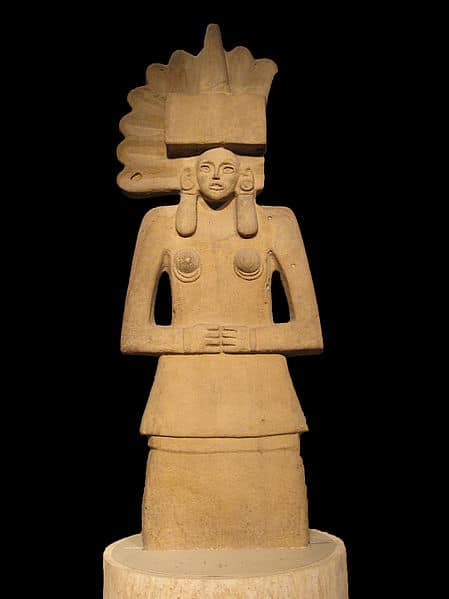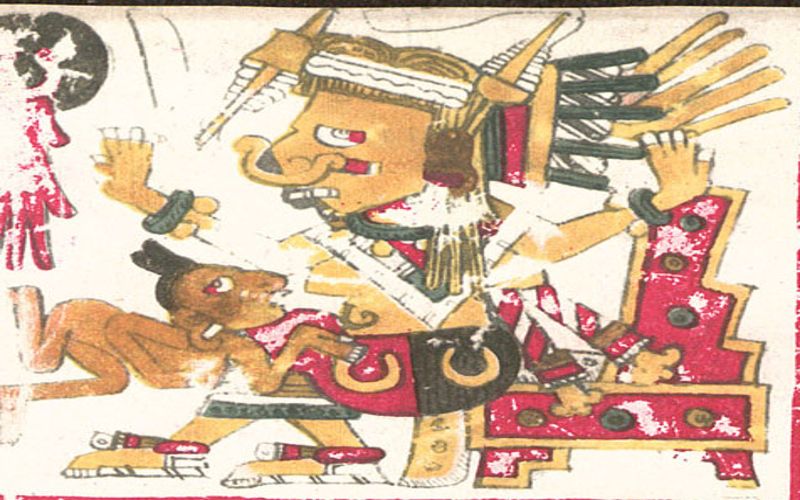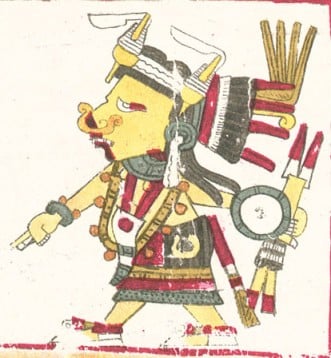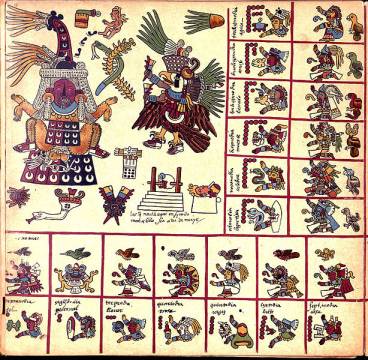For some reason, humans have a complicated relationship with sex and sexuality. The sex topic was fascinating and appealing, yet controversial and even shameful for many civilizations. The Aztecs weren’t any different, and their outlook on sex was perfectly encapsulated in Tlazōlteōtl, the goddess of lust, sex, and vice.
This goddess embodies many aspects of sexual relationships and their consequences, and she is a far more complex figure than one might think at first glance. Learning more about this goddess is a great way to explore your sexuality, so read more!
Tlazōlteōtl’s Origin Story
Unlike other Aztec goddesses, we don’t know much about Tlazōlteōtl, how she became the goddess, or which gods were her relatives, but there is a reason behind this. You see, Tlazōlteōtl wasn’t originally an Aztec goddess.
Tlazōlteōtl was originally the deity of the Huaxtec people. The Huaxtec civilization is an ancient Mesoamerican and Pre-Colombian civilization that exists even today. At one point in history, Tlazōlteōtl joined the Aztec pantheon.
The Name
Her name comes from the Nahuatl word “tlazōlli,” which literally means filth, dearth, garbage, old, and deteriorated. The other part of Tlazōlteōtl’s name was also a Nahuatl word, “teotl,” which was a Nahuatl suffix for deity names.
With this interpretation, Tlazōlteōtl’s name literally meant “the one that eats filth.” However, some scholars point out that Tlazolli has roots in the word “zolli,” a Nahuatl word for the quail bird. This bird is associated with fertility, and it inhabits places near the ground.
This wordplay is most probably intentional, as it perfectly sums Tlazōlteōtl’s role as the goddess of sin (filth) and sex (fertility).
Quadripartite Goddess
Tlazōlteōtl also had another name, Ixcuinan. Under this name, she was known as the quadripartite goddess composed of four sister goddesses. The oldest sister was Tiyacapan, the younger one was Tēicuih, the middle one was Tlahco, and the youngest one was Xōcotzin.
These four sisters were four aspects of Tlazōlteōtl, each one being in a different stage of life. Tlazōlteōtl was sometimes a young woman that carelessly tempted people to sin. Some other times, she was a bit older, and she ruled over gambling and uncertainty.
When she was in her middle age, Tlazōlteōtl absorbed human sins. As she reached her old age, Tlazōlteōtl took over a role of a hag that preyed on the youth and tried to corrupt it.
These phases of life also correspond to the lunar phases. This is another example of the parallels between the lunar cycle and fertility, femininity, and different life phases.
Tlazōlteōtl’s Role In Aztec Religion
Since Tlazōlteōtl was so multi-faceted, her role for the Aztec people was also complex. She had different roles depending on the situation and the people involved. However, each one of her roles was equally important and equally impactful on Aztec society.
The Temptress
In this role, Tlazōlteōtl actively tempts and inspires people to sin and indulge in various escapades. However, even though she encourages such illicit behavior, Tlazōlteōtl also presents her immoral followers with unique gifts – various STDs.
Tlazōlteōtl doesn’t judge you if you indulge in forbidden sexual encounters or any other sexual relationships that society sees as filthy and immoral. After all, she’s the protector of adulterers and other sinners. It’s just that STDs are a price you have to pay for those moments of pleasure.
The Gambler
Sources about Tlazōlteōtl’s role as a goddess of gambling and uncertainty are scarce. However, it is not so hard to connect gambling and uncertainty with a life of sin. After all, gambling is one of the most common vices in the world.
Uncertainty simply follows gamblers, and it is also present in the life of adulterers and all those that indulge in sinful lives. This uncertainty is contradictory to the safety and peace of living piously.
The Purifier
While Tlazōlteōtl “rewards” her sinful worshippers with STDs, guilt, and even broken marriages, she is also there to help them wash away their sins. But there is one catch: she offers to purify you only once during your lifetime.
This is why most Aztec people went through Tlazōlteōtl purification rituals when they reached an elderly age, i.e., when they were no longer able to sin. The sinner had to confess all of their sins to the priest, and the priest would choose the appropriate punishment.
After that was all done, the repentant person was considered cleared from their sins through the mercy of Tlazōlteōtl.
The Corruptor
When she assumed her oldest form and the role of the oldest sister, Tlazōlteōtl was a mean hag that preyed on the youth. In a way, this is a similar role to the youngest sister, the temptress.
However, while the young Tlazōlteōtl was a temptress, she was more carefree. Also, she didn’t tempt people out of malice. She was just showing the people all of the hidden and forbidden pleasures.
With the old Tlazōlteōtl, things seem to be a bit different. She is much more calculated, and she specifically targets naive, innocent, and easily swayed youth. She doesn’t tempt them just for fun, as her goal is to corrupt them and make them sinful.
Tlazōlteōtl – The Dirt Eater
This aspect of Tlazōlteōtl is actually closely connected to her purifying role. In this role, we see Tlazōlteōtl as the eater of excrement, filth, and everything else that’s impure, dirty, disgusting, and repulsive.
So, how can Tlazōlteōtl as the excrement eater be related to Tlazōlteōtl, the purifier? Simple, She takes in all of the filth and everything that’s bad, and by doing that, she makes the world clean.
By taking in all this filth into herself, she makes it sacred. Just like the earth takes in human/animal excrement and other waste matter, Tlazōlteōtl takes in all of our sins. And just like the earth gives us food by refining waste, Tlazōlteōtl gives us forgiveness after refining our sins.
Aztec Rituals for Appeasing Tlazōlteōtl
Aztecs had various festivals and rituals throughout the year that were supposed to appease their powerful god and goddesses. One of these festivals is Ochpaniztli, a festival intended to appease Tlazōlteōtl through various cleansing rituals.
Ochpaniztli was also the eleventh month of the Aztec calendar, and it was a month of cleaning and sweeping away. This month was filled with various rituals that appeased not only Tlazōlteōtl but also other gods and goddesses.
These rituals included human sacrifices, mostly of virgin girls and young children. A lot of effort was made to keep the soon-to-be sacrificed girls pure and clean. Sacrificed virgin girls were also flayed, and their skin was worn by the priests.
The Aztec women would engage in mock battles, throwing flowers and small branches at each other. Then, they would sweep the streets as a symbol of cleansing.
The Emotional and Spiritual Symbolism of Tlazōlteōtl’s Story

Just like with every other Aztec goddess, there is so much to learn for Tlazōlteōtl. At first, when you just think of her as some excrement-eating deity, you probably wonder what is there to learn. Don’t eat feces? Well, this “wisdom” is quite obvious, isn’t it?
However, there are some more subtle lessons to learn from Tlazōlteōtl. There are also many benefits of letting Tlazōlteōtl into your life, so let’s take a closer look at some of them.
Making The Good Out of The Bad
I already explained the parallels between Tlazōlteōtl’s dirt consumption and the earth’s absorption of fecal and other waste matter. In both instances, Tlazōlteōtl and earth take all the filth into themselves, leaving the world pure of dirt.
However, they don’t just absorb the filth; they make it into something useful and beautiful. Fecal and waste matter make the soil fertile, and the same is with Tlazōlteōtl – all the human sin makes her fertile.
So, what can we learn from all of this? We can learn to be more like Tlazōlteōtl and make something good out of all the bad things that surround us. These bad things can be life circumstances or our own flaws.
It doesn’t matter what you consider filth or a bad thing. The bottom line is you should ask yourself, “How can I transform this into something good?” or “How can I turn this bad situation to my advantage?”
Sure, this is easier said than done, but we cannot escape from bad things in our lives. Filth is just as important a part of our lives as nice things are. We can pretend it doesn’t exist and try to hide it, but we cannot make it disappear.
Let’s accept that we aren’t perfect and that each one of us is sometimes “dirty” in one way or another. It is all part of human existence, and we should embrace it and try to make something good out of it.
Playing Different Roles
It might seem weird that Tlazōlteōtl manifests as four different goddesses with somewhat conflicting personalities. However, when you think more about it, it isn’t that weird, and everyone is like Tlazōlteōtl.
You don’t believe it? Are you the same person when around your parents, friends, work colleagues, and your partner? They all see a slightly different version of you. Even when you just take your friend group into consideration, each one of your friends has a slightly different picture of you.
Does that mean something is wrong with you? Of course not! It is completely normal that you don’t act the same when around different people. So often, people use the term “double-faced” in a negative context, but we all play different roles in different circumstances.
Mother, Wife, Harlot
The issue of different roles is especially important for us women. So often, society tries to put us in a mold and fit us into a single category. If you are a mother, you can’t be sexual; if you are pretty, you can’t be smart, etc.
By embracing Tlazōlteōtl and all of her manifestations, we also embrace that we are multi-dimensional persons, not just one-dimensional ideas of what we should be.
Accepting Our Sexuality
Finally, Tlazōlteōtl teaches us to accept our sexuality and to satisfy our needs. So many gods, goddesses, and religions are pro-abstinence unless you are married. Exploring your sexuality in a healthy way is a great way to improve your relationships and learn how to love yourself.
Tlazōlteōtl also used STDs as punishment for those that indulged a bit too much. In today’s world, there are so many ways to prevent or treat such diseases. Make sure to use protection and to visit your gynecologist regularly.
Living In an Uncertain World
During our lives, we all tend to make plans and attempt to predict the course of life. However, one can never know what tomorrow brings, and this feeling of uncertainty can be terrifying.
Once we accept that nothing in life is granted and that we can’t control everything, the whole uncertainty becomes more bearable. After all, this uncertainty makes life much more exciting and interesting!
Tlazōlteōtl’s Relationship to Other Goddesses
Tlazōlteōtl is one of the several Aztec fertility goddesses. As such, she is closely related to Xōchiquetzal, Chalchiuhtlicue, Cōātlīcue, Coyolxāuhqui, and many others.
Such a large number of fertility goddesses might be surprising, but it actually makes sense. Aztecs relied on agriculture to sustain them, and even the slightest weather deviation or crop failure could be catastrophic.
Fertility goddesses were the ones who prevented these catastrophes from happening. They fed, protected, and nurtured Aztec people. Of course, if they were in a good mood.
Also, Aztecs believed that woman’s body was sacred because it could create a new life. Every new life made the Aztecs numerous and more powerful. It is easy to see why they valued fertility so much and why they worshipped so many fertility goddesses.
Tlazōlteōtl’s Appearance and Depiction
Aztecs immortalized their gods and goddesses in pictorial manuscripts called codices (singular: codex). Many of those codices survived up until today, and they allowed us to see how Aztecs imagined their deities.
Black Bubble Gum
Since Tlazōlteōtl was an eater of dirt/excrement and the devourer of sin, she was depicted as having a black area around her mouth. However, there is another reason behind this detail, and it will surprise you.
Aztec unmarried women and girls used to chew bitumen. Yes, bitumen – the oily, viscous substance used for making asphalt. Bitumen is naturally found all over the world, and Azects chewed it along with chicle (natural gum) to keep their teeth and mouth clean and fresh.
But that wasn’t the only reason for chewing bitumen. Chewing bitumen was a symbol of liberated sexuality, and one could only see girls and unmarried women doing it in public. Aztec men also chewed bitumen, but never in public. A man who publicly chewed bitumen was labeled as homosexual.
Other Details
A black mouth isn’t the only notable detail in Tlazōlteōtl’s depictions. She wears no clothes except for a headband made of spindles and seashells. Again, spindles are used as a symbol of fertility and sexuality.
Her breasts are a little saggy, and she has a wrinkled paunch. This is a sign that she already gave birth at least once. As the cleaner of the sins, Tlazōlteōtl is riding a broom. She holds a red snake in her hand as a symbol of fertility and menstrual flow.
Tlazōlteōtl And Her Christian Renditions
Even by today’s standards, Tlazōlteōtl is obscene. Can you imagine how obscene she seemed to catholic Spanish conquistadors that were accustomed to worshipping virginal female saints only?
She was never officially syncretized with any of the catholic saints, but there are some striking similarities between Tlazōlteōtl and some Biblical heroines. Probably the two most significant women in the Bible are Eve and Virgin Mary.
Tlazōlteōtl is both Eve and Mary. Just like Eve tempted Adam to bite that apple, Tlazōlteōtl tempts people to take a bite of sexual sins. Just like Virgin Mary became a nurturing, motherly, and forgiving figure for Christians, Tlazōlteōtl was all of that for Aztecs.
Every woman carries Eve, Mary, and Tlazōlteōtl within herself.
Tlazōlteōtl-Like Goddesses From All Around The World
It seems that Tlazōlteōtl is the only filth-eating goddess in the world, and that is hardly surprising. So, if you want to find a goddess that’s similar to Tlazōlteōtl, your best choices are certainly the fertility goddesses.
Fortunately, there are so many of them, and every religion has at least one. Some of the most famous fertility goddesses are Ishtar, Isis, Freya, Parvati, Hathor, Oshun, Ix-Cacao, and many more. Since she is also the goddess of sex and sin, Tlazōlteōtl is similar to Aphrodite and Venus.
Legacy

Tlazōlteōtl is certainly a complex and fascinating goddess, and once you learn more about her, you realize why she was so highly revered by the Aztecs. She isn’t grossed out by any filth or sin that the human body and mind can produce. On the contrary, she devours that filth and cleans the world.
The concept of sin eaters isn’t unique to Aztecs. Many religions and cultures have this concept, and it is also interesting to fiction writers. In most cases, sin eaters are shunned by society because people don’t want to be reminded of their filth and transgressions.
However, Tlazōlteōtl doesn’t care what puny mortals think of her. After all, they all repent her sins to her sooner or later. She has enough time and patience to wait…
Symbols
Using everyday objects or even plants or animals as symbols for various deities was a way to feel closer to these deities. We can’t touch, see, or hear gods and goddesses, but we can do all of that with their symbols. When one surrounds themselves with such symbols, the deity is more likely to grant protection.
General
The first things that come to mind when thinking about Tlazōlteōtl are certainly dirt, filth, garbage, and excrement. However, since she cleans the world by consuming these nasty things, Tlazōlteōtl should be represented by a broom. After all, some depictions show Tlazōlteōtl riding a broom.
Some other symbols of Tlazōlteōtl are spindles and seashells, both symbols of sexuality, virility, and fertility.
Animals
Jaguar is a good choice for Tlazōlteōtl’s symbol as this goddess is associated with the day sign of the jaguar in the Aztec calendar. Jaguars symbolize power, stealth, strength, and leadership. They also symbolize beauty, fertility, and hidden carnal desires.
The snake is another great symbol for Tlazōlteōtl, especially any snake of red coloring, because it symbolizes menstrual flow and fertility related to the menstrual cycle.
Plants
Tlazōlteōtl is also known as Ixcuinan, the Goddess of the Cotton. The cotton plant can be quite messy when you pick it, but after you use a spindle to weave it, you get one of the best fibers in the world. Tlazōlteōtl is like a skilled weaver that takes all of our mess and transforms it into something beautiful and valuable.
Perfumes/Scents
Again, probably the first scent that comes to mind when you think of a goddess called Dirt Eater is certainly not a pleasant one. However, she is also a temptress and a seductress, and perfumes/scents that reflect that are perfect Tlazōlteōtl symbols.
Jasmine, sandalwood, vanilla, musk, rose, and ylang-ylang are definitely some of the most seductive scents. As such, they are perfect as Tlazōlteōtl’s symbols.
Gems and Metals
Garnets are gemstones that symbolize passion, lust, sex, fertility, and intimacy. They are of dark red color, and as such, they are perfect symbols of Tlazōlteōtl. Another great choice is a ruby stone, but garnets have that “dirty” energy that makes them more appropriate for Tlazōlteōtl.
Goddess Jewelry
There are many reasons why you might want to keep a healing crystal or stone close to you. Getting closer to your goddess by wearing her color or crystal is a great one. That they also look great as jewelry only makes it so much better!
Here is a guide to crystal jewelry you hopefully will find helpful. In it is a list of 30+ crystals and links to some really great looking jewelry with that crystal or stone. Enjoy!
Colors
Definitely red and black. Red is a symbol of blood, passion, lust, menstrual blood, and fertility. Black carries many different meanings, and one of them is dirt, sin, vice, and darkness, all of the concepts that Aztecs associated with Tlazōlteōtl.
Meditations
- Tlazōlteōtl, help me make some good out of all this evil surrounding me
- Help me accept my dark side just as I accept my good side
- Teach me how to embrace my sexuality and express it in a healthy way
- Forgive my past transgressions and close your eye to the future ones
- Make me fertile and in touch with my life-giving qualities
- Tlazōlteōtl, help me clean my mind, my soul, and my life and devour my sins
- Help me be seductive and tempting to people that I want to attract into my life and repulsive to those that I want to deter away from me
Want To Bring More Tlazōlteōtl Qualities Into Your Life?
- As crazy as this might sound, find a local spa that offers a mud bath and go try it out. Mud baths offer several health benefits, and they could be an interesting experience for you that will bring you closer to Tlazōlteōtl.
- Start gardening. You will work a lot with various types of soil and dirt, and you will learn that getting dirty is not that bad. You can always easily wash your hands and your clothes, and you will have so much fun.
- When you start gardening, you will see how enjoyable it is to watch a new life grow out of the dirt. You will realize the significance of Tlazōlteōtl consuming dirt and giving birth to a new life.
- Join some cleaning activities with a local volunteer group if there is one in your proximity. This is a fun and useful way to spend your time, as you will contribute to making our environment cleaner while also meeting new people.
- Explore your sexuality. What are your hidden desires? Do you have a way to fulfill them? Can you make sure that your desires aren’t hurting you or anyone else who is involved? These are all important questions to ask yourself before you act on your impulse.
- Accept that not everything in this life is picture-perfect. Accept the ugly just like you accept the pretty. Don’t try to censor the ugly, it is all part of life, and there is some hidden beauty even in the things that may look ugly at first.
- Surround yourself with Tlazōlteōtl’s symbols. Wear red and black clothes and accessories with garnets and rubies. Instead of achieving Tlazōlteōtl’s black mouth through eating dirt, try some black or dark brown lipsticks.
Featured Image Credit: Wikimedia Commons




